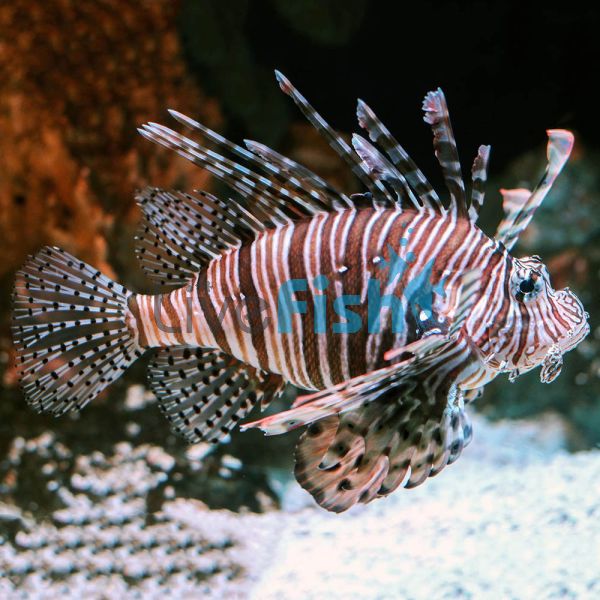Volitan Lionfish - Large
These amazing hunters are as deadly as they are beautiful. With their long venomous spines and extravagant fins, the Volitan Lionfish makes an intimidating attraction to your aquarium.
The variation of colouring available with the Volitan Lionfish is outstanding. This vertically striped predator can have many numbers of bands all ranging from red to brown, black and everything between. It has long elegant pectoral fins which are disguised by even longer spines. At least one of the stripes even runs across its eyes to help disguise itself. The spines and fins are used to its advantage while hunting by helping to disguise movement and get closer to their prey to trap them.
There are no visible differences between males and females. Although spawning in captivity has been successful, raising the juveniles has not.
One of the most important things to remember about this fish is that it can and will hurt you if you are not paying attention. Be aware of where the fish is at all times when cleaning the tank as it can easily arch and the spines will go through even the thickest of rubber gloves. While not life-threatening, the pain can last for up to 24 hours and the unlucky few who have a reaction to the venom will need a visit to the hospital.
These fish were originally only found in the Pacific and Indian Oceans, in Australian waters across to the Red Sea. Inhabiting depths down to 50 metres they hang around in lagoons, seaward reefs estuaries and even inshore areas. A few decades ago they started to be spotted in tropical Atlantic waters such as the Gulf of Mexico where they quickly grew to become an invasive species with no natural predators having been released by the aquarium trade.
Tank Recommendations for Volitan Lion Fish
The smallest tank size for this species of fish is 450 litres as they can grow quite large. They will need plenty of places to hide during the day as they are quite nocturnal creatures. They will venture out into the aquarium more often as they become more comfortable. Lighting and substrate are unimportant but do not aim the air pumps at the provided hiding places as it will disrupt sleeping patterns. One of the most important things to remember is that this fish can grow up to 38 cm (15 inches) and will need plenty of horizontal space for turning so keep in mind a longer rather than taller tank as well as enough breadth for positioning.
Suitable Tank Buddies
Only keep with fish larger than itself because Lionfish will eat pretty much anything smaller. Pay attention to the number of other species you add to the tank as overcrowding could cause fish to get spiked accidentally.
Usually Compatible
As long as they remain bigger than your Lionfish great tank buddies could include Pufferfish, Snappers, Angelfish and even Groupers. The Lionfish will also not bother Cucumbers, Starfish, Hermit Crabs or live coral. They can be kept with other Lionfish as long as the aquarium size is large enough.
Sometime Compatible
Appropriate sizes of Sharks and Rays can be successful. Take caution when adding invertebrates and crustaceans as they can be easily preyed upon.
Rarely Compatible
Damsels, Seahorses and Pipefish along with other smaller delicate fish will be eaten. Anglerfish of the same size as the Lionfish have been known to eat them so are best avoided.
Feeding Your Volitan Lionfish
These fish are carnivorous and will eat almost anything. It is worth remembering that adults do prefer fish meat as opposed to the crab loving juveniles. Do not feed them fresh water sourced food as their stomachs cannot handle it. Try them with a variety of frozen or thawed marine flesh of medium size 2-3 times a week. Take care with portion sizes as choking is a possibility. Live food can also be offered.
| Scientific Name | Pterois Volitans |
|---|---|
| Common Names | The Volitan Lion Fish, is also known as the Volitan's Lion Fish, Common Lion Fish and the Red Lion Fish. |
| Diet | Carnivore |
| Fish Family | Scorpaenidae |
| Lifespan (years) | 18 |
| Max. Length (cm) | 38 |
| Min. Tank Volume (l) | 450 |
| Origin | Indo-Pacific, Atlantic (non-native) |
| Reef Safe | With Caution |
| Sociability | Peaceful |
| Venomous | Yes |
| Water Conditions | 17-28° C, dKH 8-12, pH 8.1-8.4, sg 1.023-1.025 |



